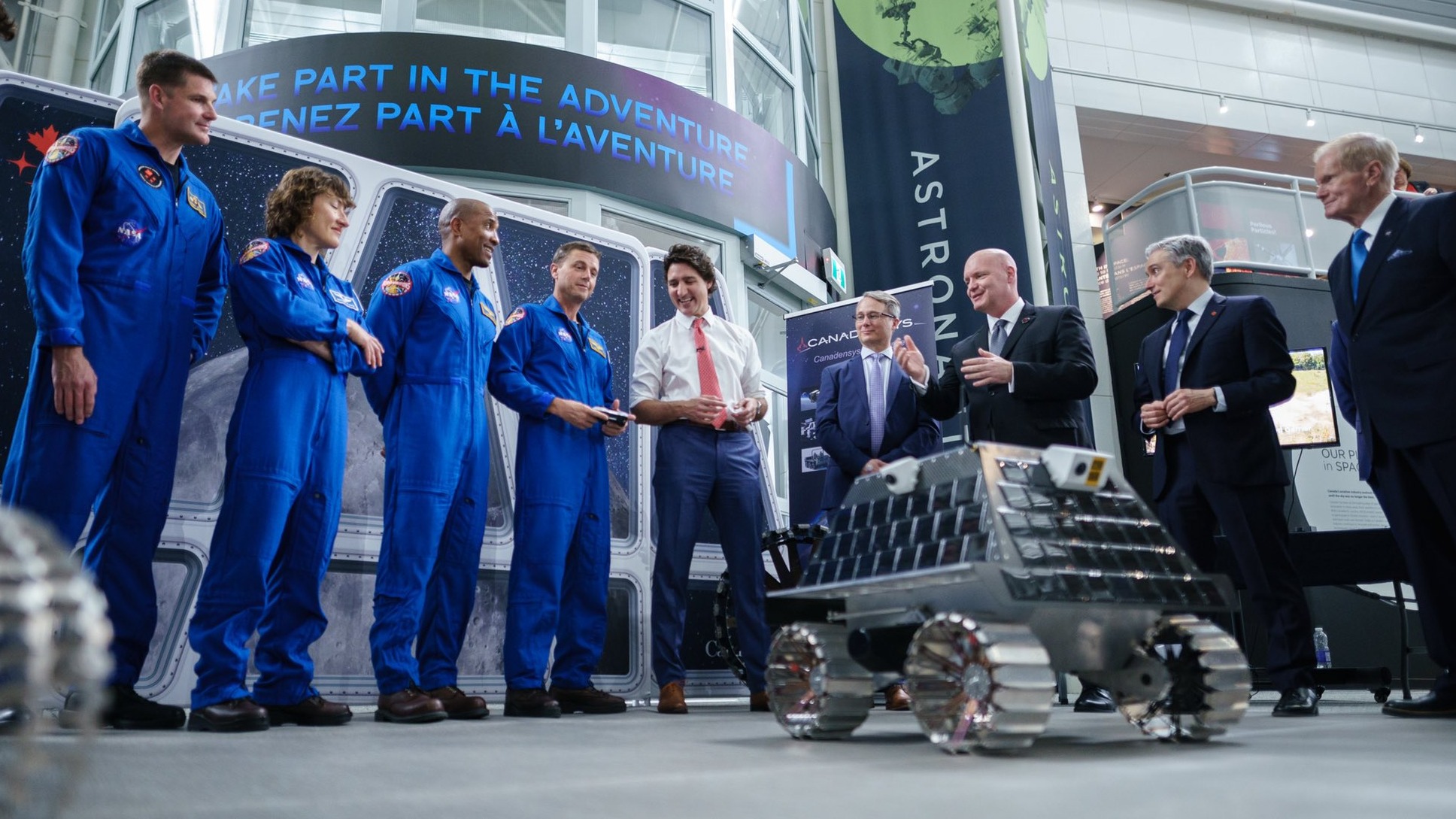Winter is coming: Artemis 2 moon mission gets boost from Canadian cold
'I shrugged and said, Obvious. Winter.'

The secret to Canadian success in space? Cold weather, says the country's leader.
Canada will send an astronaut around the moon on NASA's Artemis 2 mission, as Jeremy Hansen becomes the first non-American to leave low Earth orbit. Hansen and his three NASA crewmates (Reid Wiseman, Christina Koch and Victor Glover) are scheduled to launch on the Artemis 2 mission no earlier than November 2024.
The Artemis 2 crew came to Canada this week to meet up with space folks, students and politicians. So why is Canada on this moon mission? Prime Minister Justin Trudeau rhetorically asked during a livestreamed event on Tuesday (April 25).
"I shrugged and said, 'Obvious. Winter,'" he told laughing attendees at the Canada Aviation and Space Museum in Ottawa, while sitting alongside the Artemis 2 crew and NASA Administrator Bill Nelson on stage. (Canadian Space Agency President Lisa Campbell served as moderator.)
Related: Four for the moon! NASA names Artemis 2 astronaut crew for 1st lunar mission since Apollo
Trudeau emphasized that working in Canada's north represents "some of the harshest environments" available to humans, although he acknowledged Floridian engineers (for example) have their own challenges to work with. Still, the cold of space has many similarities to the cold of the Arctic, including having to deal with inevitable equipment breakdowns in harsh conditions and remote locales.
Teamwork, Trudeau nevertheless added, is what will get people through the worst weather and through tough spaceflight situations. That's an allusion, by the way, to how Canadians approach space: they focus on niche areas like robotics or health, to assist larger partners like NASA with big mission goals.
Get the Space.com Newsletter
Breaking space news, the latest updates on rocket launches, skywatching events and more!
"No matter how tough you are, how strong you are, every now and then you're going to need help from a neighbor or a friend, whether it's boosting your car, [or] whether it's making it through a long winter snowstorm in the countryside," Trudeau said.
While plenty of Canadian tech has made its way to space, perhaps the most famous is the Canadarm line, now managed by the company MDA. After the original iteration funded Canadian missions during the space shuttle program, Canadarm2 (along with handy robot Dextre) went on to pay for slots for the nation's astronaut on the International Space Station. Artemis 2's seat for Hansen, incidentally, was brokered with Canadarm3, which will service NASA's planned Gateway moon-orbiting space station.
Related: Artemis 2's Canadian astronaut got their moon mission seat with 'potato salad'

Canadians and their technology have been integral to NASA for decades. Perhaps the most famous example was a group of engineers from a canceled Canadian jet program known as the Avro Arrow, who migrated to a very young NASA in 1959.
Those few dozen people assisted in numerous early spaceflight programs at NASA, including the Apollo moon landings. Meanwhile, Canadian company Devtek (today's Héroux-Devtek) manufactured the "legs" that were used aboard all of NASA's human lunar landers — just one more example of Canadian tech on U.S. missions across decades of collaboration.
Nelson said that long-standing relationship is part of why Canada received a coveted seat aboard Artemis 2. "It's significant that, for the first time back to the moon in over a half century, that Canada is our international partner," he said at the event.
The Canadian Space Agency (CSA) has several programs directly connecting tough space living to helping those populations living in the often dark and cold far north, such as its Deep Space Health Care Challenge and (with NASA) a Deep Space Food Challenge.
"If we can't grow food in the Canadian Arctic, how do we expect to be able to grow it on the moon or on Mars? It's the same with remote health care," Artemis 2 astronaut Hansen, representing the CSA, said at the same event.
Hansen added that local Arctic populations, including Indigenous people, have solutions from hard-earned experience that would be useful for communities on Earth and in space alike.
"There's a lot of genius across the country within these areas," Hansen said of remote populations. "The technology has changed to the point [that] we could leverage that knowledge that's in our country already to solve it for the Arctic — for remote communities. Then take those solutions to the moon, and take them to Mars, with our international partners. There's just tremendous opportunity there."
Elizabeth Howell is the co-author of "Why Am I Taller?" (ECW Press, 2022; with Canadian astronaut Dave Williams), a book about space medicine. Follow her on Twitter @howellspace. Follow us on Twitter @Spacedotcom or Facebook.
Join our Space Forums to keep talking space on the latest missions, night sky and more! And if you have a news tip, correction or comment, let us know at: community@space.com.

Elizabeth Howell (she/her), Ph.D., was a staff writer in the spaceflight channel between 2022 and 2024 specializing in Canadian space news. She was contributing writer for Space.com for 10 years from 2012 to 2024. Elizabeth's reporting includes multiple exclusives with the White House, leading world coverage about a lost-and-found space tomato on the International Space Station, witnessing five human spaceflight launches on two continents, flying parabolic, working inside a spacesuit, and participating in a simulated Mars mission. Her latest book, "Why Am I Taller?" (ECW Press, 2022) is co-written with astronaut Dave Williams.









